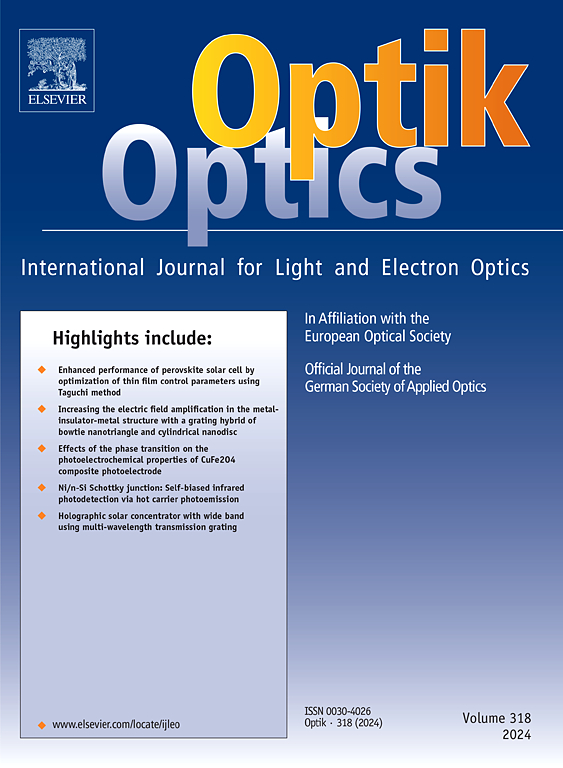Graphene-based series-fed plasmonic antenna array optimised with metaheuristic algorithm for 6G THz communications
IF 3.1
3区 物理与天体物理
Q2 Engineering
引用次数: 0
Abstract
This paper presents the modelling and optimisation of a compact series-fed plasmonic antenna array operating in the terahertz (THz) frequency range from 1 THz to 1.8 THz, suitable for 6 G communication applications. The proposed antenna is designed using graphene over a polyimide substrate, taking advantage of graphene’s tunable plasmonic properties and the substrate’s mechanical flexibility. The antenna elements are configured using a single resonator structure, comprising a rhombus-shaped resonator and an octagonal resonator, connected via a central cross dipole to ensure broadband impedance matching and stable radiation characteristics. Firefly Algorithm (FFA) is employed for optimisation, improving the antenna’s performance parameters. A series-fed configuration is adopted to achieve compact integration with directional gain. The design is extended to a two-element multiple-input multiple-output (MIMO) system for improved data throughput. The array occupies a physical size of 125 × 28 µm, corresponding to 0.417λ × 0.093λ at 1 THz, and achieves a fractional bandwidth of 55.5 %. The realized gain of the antenna is greater than 7.8 dBi and a total efficiency above 80 % across the entire operational band. Key MIMO performance indicators—envelope correlation coefficient (ECC), diversity gain (DG), total active reflection coefficient (TARC), and channel capacity loss (CCL)—are evaluated and presented, demonstrating strong isolation and diversity performance. Simulation results confirm that the optimized antenna array, using FFA, is a promising candidate for integration into compact THz front-end modules for 6 G communication systems.
基于元启发式算法优化的石墨烯串联等离子体天线阵列用于6G 太赫兹通信
本文介绍了在1 ~ 1.8 太赫兹(THz)频率范围内工作的紧凑型串联等离子体天线阵列的建模和优化,适用于6 G通信应用。该天线是在聚酰亚胺衬底上使用石墨烯设计的,利用了石墨烯的可调谐等离子体特性和衬底的机械灵活性。天线元件采用单个谐振器结构配置,包括一个菱形谐振器和一个八角形谐振器,通过中心交叉偶极子连接,以确保宽带阻抗匹配和稳定的辐射特性。采用萤火虫算法(FFA)进行优化,提高了天线的性能参数。采用串联馈电结构,实现了定向增益的紧凑集成。该设计扩展到一个双元多输入多输出(MIMO)系统,以提高数据吞吐量。该阵列的物理尺寸为125 × 28 µm,在1 太赫兹下对应0.417λ × 0.093λ,分数带宽为55.5 %。该天线的实现增益大于7.8 dBi,整个工作频带的总效率在80% %以上。MIMO的关键性能指标——包络相关系数(ECC)、分集增益(DG)、总主动反射系数(TARC)和信道容量损失(CCL)进行了评估和展示,展示了强大的隔离和分集性能。仿真结果证实,采用FFA的优化天线阵列是集成到紧凑的6 G通信系统太赫兹前端模块中的有希望的候选天线。
本文章由计算机程序翻译,如有差异,请以英文原文为准。
求助全文
约1分钟内获得全文
求助全文
来源期刊

Optik
物理-光学
CiteScore
6.90
自引率
12.90%
发文量
1471
审稿时长
46 days
期刊介绍:
Optik publishes articles on all subjects related to light and electron optics and offers a survey on the state of research and technical development within the following fields:
Optics:
-Optics design, geometrical and beam optics, wave optics-
Optical and micro-optical components, diffractive optics, devices and systems-
Photoelectric and optoelectronic devices-
Optical properties of materials, nonlinear optics, wave propagation and transmission in homogeneous and inhomogeneous materials-
Information optics, image formation and processing, holographic techniques, microscopes and spectrometer techniques, and image analysis-
Optical testing and measuring techniques-
Optical communication and computing-
Physiological optics-
As well as other related topics.
 求助内容:
求助内容: 应助结果提醒方式:
应助结果提醒方式:


